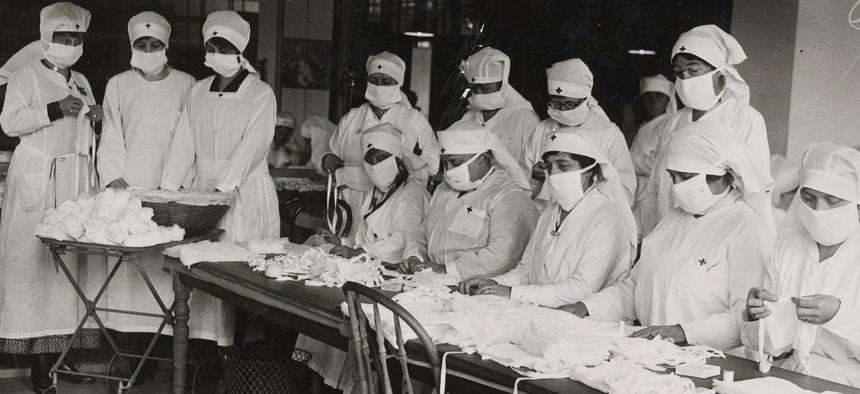Were they still with us, that generation could tell us much about what we face now—what it was like to go on with daily life in the midst of travel shutdowns, school and business closings, and bans on public gatherings of any size. State and local governments imposed a variety of restrictions on daily life that constitute “social distancing” measures in modern terminology. They had little choice: There was no cure and no vaccine for this particularly deadly strain of flu that spread easily from person to person. For COVID-19, health officials emphasize that similar measures are “the only viable strategy at the current time.”

Red Cross workers making anti-influenza masks for soldiers in camp in Boston in 1918. National Archives file photo
How a Fragmented Country Fights a Pandemic
During the 1918 influenza crisis, public officials faced similar challenges to the ones American government is confronted with today.
Over the past week, Americans have seen a sudden, dizzying variety of social-distancing measures ordered by mayors, county officials, and state governors. For better or worse, the nation’s defense against pandemics depends on such local decision making. This is because the unique system of federalism in the U.S. makes it one of the most decentralized public-health systems in the world.
The U.S. legal system has been here before—just over a century ago, during the pandemic influenza of 1918–1919, the most severe pandemic in recent history. Then, too, public officials faced constraints on their knowledge, authority, and capacity to deal with the crisis. The result was a patchwork approach that radically, if temporarily, changed American life.
Tucson, Arizona, even featured what a local reporter called “influenza court,” to handle the cases of citizens who had been issued citations for not wearing face masks, or not wearing them properly (including cutting holes in masks to smoke). The police chief declared, “We are going to enforce this ordinance or close up the town entirely.” Fines were generally $10. Judges would listen to excuses, although they were rarely countenanced. One day in the court, 28 people appeared to appeal for relief from the $10 fine. None were excused, although some were creative. The judged noted that “when one’s mask is in the wash, it is no exemption from wearing it.” (Presumably one should stay home on wash day.) One resident wanted only “a brief privilege of fresh air”; he hated that the privilege cost him a week’s wages. The judge also held that “a pink muffler is not a legal substitute for a mask.”
A study in 2007 asked what pandemic planners could learn from the social-distancing measures imposed during the 1918–19 pandemic. The authors concluded that school closure, public-gathering bans, transportation restrictions, limited closure of businesses, and even face-mask ordinances almost certainly mitigated the consequences of what they termed “the most deadly contagious calamity in human history.” The 1918 experience, they wrote, teaches that sustained social-distancing measures are beneficial, and need to be “on” throughout the particular peak of a local experience. Despite no effective vaccine, U.S. cities that “were able to organize and execute a suite of classic public health interventions before the pandemic swept fully through the city” appeared to do better than those that did not. Judges routinely upheld the emergency measures identified in the study, recognizing the need to defer to health authorities in the face of the unknown.
The homemade face mask probably did some good as well, or at least was better than nothing, especially when caring for patients at home—akin to current advice to cough into your elbow (or a pink muffler, so long as you throw it away afterward).
Hardship, fear, and dejection undoubtedly accompanied the nearly complete shutdown of social life in many cities. Yet it also brought out a remarkable spirit of charity. For those who lived through it, the lifting of bans on public gatherings brought immediate celebration. The Los Angeles Times noted the “fiesta spirit” that pervaded that city, bringing to an end the city’s “longest funless” season. On December 3, 1918, the paper reported, “From the depression of closed theaters and other places of amusement, closed churches and assembly halls, the city reacted yesterday to the spirit of gladness.” People who had been “staying closely at home for weeks” joined the throngs downtown to celebrate, shop, attend a movie. Stores were filled with shoppers, and “long lines of people reached even out into the corridors at the Public Library.”
A return to normalcy occurred throughout the nation as public-gathering bans were gradually lifted. They celebrated when the worst was past—not even knowing the Roaring Twenties were right around the corner.
This story is part of the project “The Battle for the Constitution,” in partnership with the National Constitution Center.






